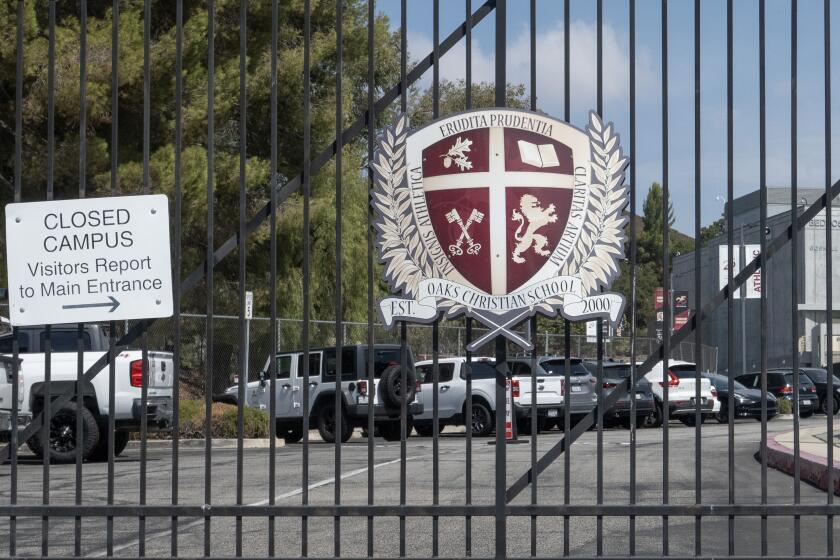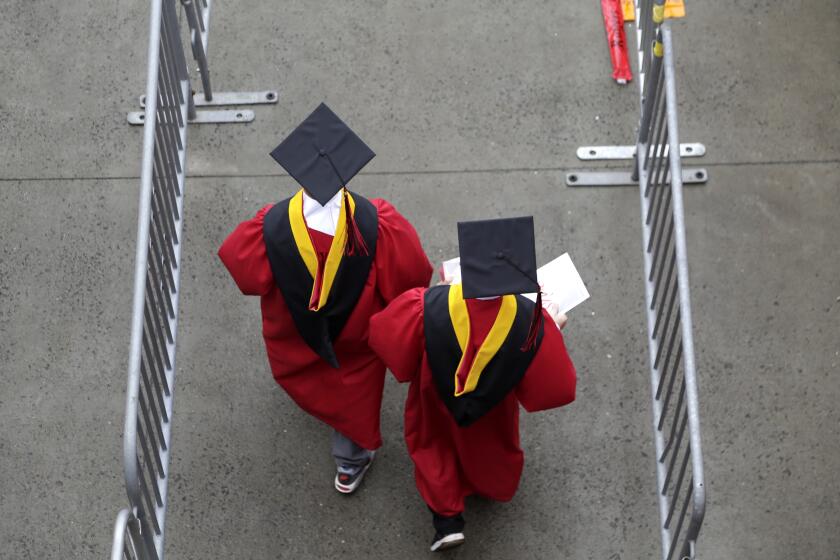Valley Colleges Make Cuts to Pay the Piper
One year ago this week, the Los Angeles Community College District was riding a long-awaited wave of optimism as a slew of new leaders and millions of new state dollars flowed in. As the fall term starts Monday, the district is cutting hundreds of classes, eliminating sports programs, and limiting library hours and other services.
Although it will once again enjoy a relatively robust budget, thanks to a healthy state economy and the increasing willingness of taxpayers to fund education, the district’s years of deficit spending have brought it to the brink, officials say. And the time to balance the books is now.
“It will hurt,” said Chancellor Bill Segura of cuts that will be made at eight of the nine campuses in the country’s largest community college district. But if the district continues its past course of deficit spending, he said, the state could well take it over, as happened with the beleaguered Compton Unified School District.
“We could eat up our reserves before the year is out and go into receivership if we don’t do this,” said Segura, who took over as chancellor last year.
The two hardest-hit campuses are in the San Fernando Valley--Pierce College in Woodland Hills and Mission College in Sylmar--though for different reasons. West Los Angeles College is in the best financial shape of the eight in-debt schools, with just $250,000 to trim.
Right now, only Mission expects to cut its athletic program. It will also eliminate a host of classes, as well as trim library hours and a citizenship program. At other campuses across the district of 100,000 students, administrators are still grappling with what to cut.
*
Although the district has endured several budget crises in recent decades, the recent trend that saw campuses overspending and then borrowing money to make up the difference began during the recession of the early 1990s and spread rapidly, said Bonnie James, the district’s vice chancellor of operations.
In 1994, three campuses were running deficits, James said. The next year, that figure grew to six. Now every campus but one, East Los Angeles College, is in the red.
“We . . . can no longer permit that to happen,” James said. “What we are asking our colleges to do is simply live within their budget.”
The schools must also begin paying back their debts.
According to the latest projections, Pierce College will have the largest shortfall to make up this coming year, more than $3 million. That figure is up from the $2.5 million officials had estimated earlier this summer, but considerably less than the $4.3 million campus officials were sweating over just hours before the district board met on Wednesday and detailed the latest numbers.
Pierce has suffered declining or flat enrollment for years, as well as a series of administrative shake-ups. Mission, on the other hand, has grown so quickly that district funding was unable to keep up under an old funding formula that effectively punished thriving campuses.
Mission College comes in second to Pierce in terms of deficit size, with $2.4 million to make up, but the Sylmar campus is likely to feel the pinch more than any other. One of the smallest and newest campuses in the system, Mission has a shortfall equal to more than a quarter of its $9-million budget. Pierce’s deficit is about 7.5% of its $23-million budget.
As school begins, however, Mission may actually have a leg up on some of the other campuses in one respect. The school began planning its cuts in early July, causing an uproar and leading school supporters to picket a district Board of Trustees meeting. But the campus’ foresight also initiated the difficult process several weeks before some other campuses.
“It’s hard to cancel classes once there are students in them,” said Mission President William Norlund.
*
When classes began last fall, the district was enjoying its fattest operating budget in years, as well as an extra $22 million in voter-approved capital funds to repair aging campuses and a voting public that appeared increasingly willing to part with education tax dollars. Still, no one predicted that one good year would turn around a district that has been ailing on and off for decades.
But even with the extra dollars, the district struggled.
Growth caps that had been held as low as 1% by the state during the early 1990s were raised to 10% when school began last fall. And the colleges actively sought new students, officials said, and then created courses and hired teachers to accommodate the hoped-for newcomers.
But the expected influx of recruits never materialized. Enrollment grew just 1% districtwide, meaning the district received just one-tenth of the state dollars available for growth, officials said. At the same time, the campuses had to pay for many new, and often poorly attended, classes.
Meanwhile, seeking to bring low average salaries more in line with other districts across the state, the trustees in the winter gave faculty members a sizable raise of 9% for the 1996-97 school year, and roughly 7% raises for each of the next two years.
That cheered faculty but angered many staff employees, whose salaries also fall well below those of their peers at other large California districts. The staffers, however, aren’t likely to get such increases any time soon, district officials concede.
“The combination of salary increases and deficits--you can’t do both,” James said, adding that negotiations with some union groups continue.
That’s why the deficits will have to be eliminated--which means cutting 200 classes at Mission, for example, and at least 130 courses at Pierce, thus scrambling the schedules of thousands of students. Part-time faculty may also have to be laid off, with full-time positions eliminated through attrition.
At the other district campuses, City College expects a $1.5-million deficit; Harbor, $446,000; Southwest, $1.4 million; Trade Tech, $1.4 million; and Valley, $1.4 million. East Los Angeles College is the only campus operating in the black, with a positive balance of $1.4 million.
*
Despite the specter of a “very, very tough year” ahead, in the words of James, Segura seems to have the support not only of the trustees, but of many college officials.
“There are a lot of ways that we have done business over the years that need to change,” said Mission College’s Norlund. “A lot of the cuts we made were needed. We will improve our efficiency significantly.”
Pierce College President E. Bing Inocencio, who took over last year, put it this way: “If we don’t change, we are headed for receivership--the entire district. We’ve got to change.”
More to Read
Sign up for Essential California
The most important California stories and recommendations in your inbox every morning.
You may occasionally receive promotional content from the Los Angeles Times.










